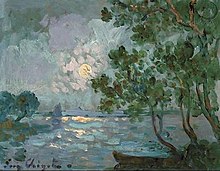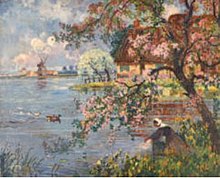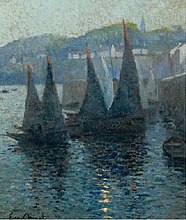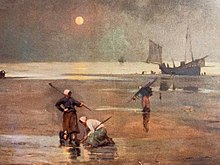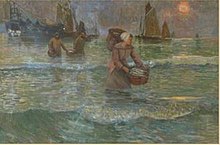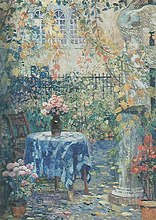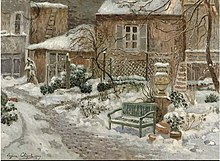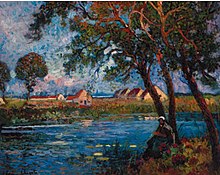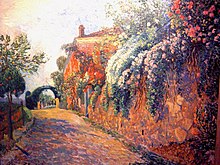Eugène Chigot
Eugène Chigot | |
|---|---|
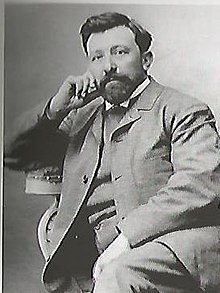 | |
| Born | Eugène Henri Alexandre Chigot 22 November 1860 Valenciennes, France |
| Died | 14 July 1923 (aged 62) Paris, France |
| Education | École nationale supérieure des Beaux-Arts |
| Known for | Oil painting, Watercolours |
| Notable work | Verrotières dans la baie,Fraipont, Juan-les-Pins. |
| Movement | Naturalism, Post impressionism, |
| Awards | Légion d'honneur - Chevalier (Knight) (1895) Legion d’honneur – Officier (Officer) (1912)[1] |
Eugène Henri Alexandre Chigot (22 November 1860 – 14 July 1923) was a post impressionist French painter. A pupil of his father, the military painter
Early years


Eugène Chigot was born in
The Colonie artistique d'Étaples
Following his pupillage in Paris, Chigot searched for an appropriate environment from where he could paint. Initially he travelled to the south of France and to Italy. At this stage in his career Chigot favoured ‘En plein air’ painting, a theory credited to Pierre-Henri de Valenciennes (1750–1819) that he expounded in a treatise entitled Reflections and Advice to a Student on Painting, Particularly on Landscape (1800)[8] developing the concept of landscape portraiture by which the artist paints directly onto canvas in situ within the landscape. It enabled the artist to better capture the changing details of weather and light.[8]
Eugène Chigot began exhibiting at the
Chigot lived in the area for most of the next twenty years initially at the villa attached to his studio in Étaples. In 1893 he married Martha Colle and spent part of his honeymoon in Berck, a favoured haunt of the impressionist painter Manet.Two years later, he bought a house in the new and wealthy resort of Le Touquet.[11] The union produced a son Paul Louis, born in 1906 who was become an eminent decorated surgeon and a daughter Mathilde. The Chigots moved again in 1902 to the western Flanders town of Gravelines at the mouth of the river Aa where he built a chalet by the sea in which to paint.[11] Chigot's output during the 1890s was of a post impressionistic style, in which he depicted beach scenes with expansive skies, atmospheric seascapes, and local châteaux often with a pond in the foreground. His figures are intimate and placed within the coastal landscape. Chigot possessed the ability to convincingly paint still and moving water.[2]
Return to Paris and the Salon d’Automne


Eugène Chigot was an active participant in the founding of the Salon d'Automne, now an annual art exhibition held in Paris, which opened on 31 October 1903.[12] Perceived as a reaction against the conservative policies of the official Paris Salon, the new exhibition was an immediate success showcasing developments and innovations in early 20th Century art. The Salon d’Automne from its inception received strong support from artists across the artistic spectrum including some of the most established artists in France that included: Paul Cézanne, Édouard Vuillard and Auguste Rodin who featured works at the inaugural exhibition. At the 1905 exhibition Chigot exhibited three canvases featuring the Flanders landscape: Le Soir à Vormouth, Place morte, Jardin en Flanders.[13] The salon also witnessed the birth of Fauvism in 1905 and of Cubism in 1910.[note 2][14]
The febrile artistic atmosphere of the later
Peintre officiel de la Marine and war artist
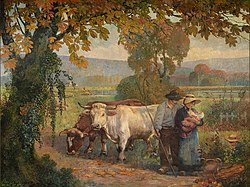
In 1891 Chigot accepted the offer to become an official painter for the
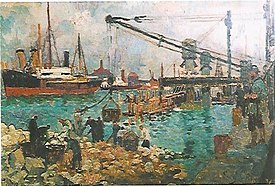
The disruption to French cultural life of the
In 1917, in his capacity as an official government artist, Chigot was approached to join the French forces at
The psychological effects of his experiences in the Great War seem to have left him in a depressed state.
Eugène Chigot died in Paris on July 14, 1923. His body was returned to Valenciennes and buried beside other members of his family at the Saint-Roch cemetery (Cimetière Saint-Roch).[2]
Public collections (selected)

Examples of Chigot's work can be found at : Musée d'Orsay,[21] Musée de France d'Opale Sud,[22] Musée Antoine Vivenel, Musée du Touquet-Paris-Plage,[23] Palais des Beaux-Arts de Lille[24]Petit Palais,[25] Musée Carnavalet,[26] Musée de Nantes,[27] and Indianapolis Museum of Art.[28]
Eugène Chigot has been the subject of several posthumous exhibitions (selected): at the
The Association des Amis d' Eugène Chigot in Touquet maintains his legacy.[citation needed]
Notes
- ^ It was whilst painting in 1911 that Édouard Lévêque, a painter from Le Touquet and a representative of the École d'Étaples came up with the notion of giving the area around Le Touquet-Paris-Plage, the somewhat enigmatic name Côte d'Opale (Opal Coast)
- ^ The Cubist contribution to the 1912 Salon d'Automne created scandal regarding the use of government owned buildings, including the Grand Palais, to exhibit such artwork. The indignation of the politician Jean Pierre Philippe Lampué made the front page of Le Journal, 5 October 1912. The controversy then spread to the Municipal Council of Paris, leading to a debate in the Chambre des Députés about the use of public funds to provide the venue for controversial art. The Cubists were defended by the Socialist deputy, Marcel Sembat.
Biography
- Antoine Descheemaeker- Colle (2008), Eugène Chigot, Sa Vie, Son Oevre Peint, Editions Henri, France. ISBN 9782917698020in French
- Jean-Francoise Louis Merlet (1910), Eugène Chigot, peintre, Paris Societè de L’edition Libre.
- Eugène Chigot, exhibition catalogue, musée Galliera, Paris, 1954.
Bibliography
- Jean-Claude Lesage /Lionel François: ‘L'École d'Étaples. Une foyer artistique à la fin du XIXe siècle’ in Revue du Louvre, no. 3, p. 57, periodical, Paris, June 2001
- Edith Marcq (2019), La Côte d'Opale et ses peintres au XIX ème siècle à la fin de l'entre-deux-guerres: l'individualité de son appellation à ses diverses représentations picturales, in french.
- Camille Mauclair (2019), Henri Le Sidaner, The Obolus Press, ISBN 978-0981178035
- Joshua Taylor (1989), Nineteenth Century Theories of Art, pages 246–7, University of California Press, USA. ISBN 0520048881
- J Turner, (2000). From Monet to Cézanne: Late 19th-century French Artists. Grove Art. New York: St Martin's Press. ISBN 0312229712- background only.
- Malcolm Baker, Andrew Hemingway, Briony Fer et al., (2018) Art as Worldmaking: Critical Essays on Realism and Naturalism, University of Manchester, ISBN 9781526114907
Gallery (selected)
References
- ^ Chigot leonore.archives-nationales.culture.gouv.fr
- ^ ISBN 9782917698020french
- ISBN 9780199773787
- ^ Edith Marcq (2019), La Côte d'Opale et ses peintres au XIX ème siècle à la fin de l'entre-deux-guerres: l'individualité de son appellation à ses diverses représentations picturales, in french
- ISBN 978-0-312-22971-9.
- ISBN 9780856704512
- ISBN 9781856695848
- ^ ISBN 0520048881
- ^ Henri Le Sidaner, (1862-1939) et la Bretagne (2002): Exposition, Pont-Aven, Musée de Pont-Aven
- ^ "Philip Wilson Steer, O.M. (1860-1942)".
- ^ a b c "Son oeuvre". www.asso-eug-chigot.org. Archived from the original on 2 April 2012. Retrieved 15 January 2022.
- ^ Salon d'automne; Société du Salon d'automne, Catalogue des ouvrages de peinture, sculpture, dessin, gravure, architecture et art décoratif. Exposés au Petit Palais des Champs-Élysées, 1903
- ^ https://archive.org/details/cataloguedesouvr1905salo Catalogue des ouvrages de peinture, sculpture, dessin, gravure, architecture et art décoratif. Exposés au Grand Palais des Champs-Élysées, 1905
- ^ "Le Journal". 5 October 1912.
- ISBN 978-0-85745-310-5.
- ^ Hamel, Catherine. La commémoration de l’alliance franco-russe : La création d’une culture matérielle populaire, 1890-1914 (French) MA thesis, Concordia University, (2016)
- ^ Eugène, Chigot. "Pax (Peace)". Carnegie Foundation: Peace Palace. Retrieved 16 December 2022.
- ^ La Presse (Journal), 25/3/1916
- ^ Letter from Martha Chigot from Dieppe to Chigot (family archive) 11/9/17, curated by association des Amis d'Eugène Chigot
- ^ Letter to Martha Chigot dated 19/3/1917 (family archive) curated by The Association des Amis d' Eugène Chigot, Le Touquet
- ^ 'Paysage, château sous le givre' (1905), oil. 54,0 cmx 73,0cm (right inset)
- ^ "L'école de Berck - Musée de Berck-sur-Mer". musee.berck.fr. Retrieved 26 July 2020.
- ^ "Musée du Touquet-Paris-Plage". Site de letouquet-musee ! (in French). Retrieved 26 July 2020.
- ^ Chigot, Eugène. "Tendresse nocturne (Peaceful evening)". Palais des Beaux Arts, Lille. Retrieved 30 August 2022.
- ^ "La foule attendant le passage du corps du général Galliéni (recto) / Une maison (verso) | Paris Musées". www.parismuseescollections.paris.fr. Retrieved 26 July 2020.
- ^ "La Bourse | Paris Musées". www.parismuseescollections.paris.fr. Retrieved 26 July 2020.
- ^ Chigot, Eugène. "Perdus au large (Perdus en mer)". Musée de Nantes. Retrieved 30 August 2022.
- ^ "Le Mazet at Juan-Les-Pins". Indianapolis Museum of Art Online Collection. Retrieved 26 July 2020.
- ISBN 9782917698020
External links
 Media related to Eugène Chigot at Wikimedia Commons
Media related to Eugène Chigot at Wikimedia Commons- http://www.artnet.com/artists/eug%C3%A8ne-chigot/



